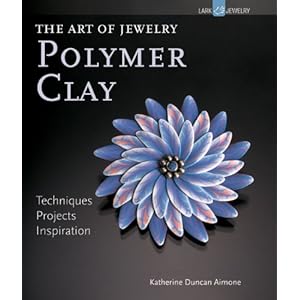The Art of Jewelry: Polymer Clay by Katherine Duncan Aimone.
152 pages, soft cover, full color.

It is a wonderful book for intermediate to advanced clayers. I do not recommend this book to beginners. The projects in the book contain just a few illustrations each, and in most cases steps are not described in full, since, being an advanced clayer, you are supposed to know how to do elementary things. I have heard some negative reviews about this book, and they mostly came from beginners, which is understandable. If you are just starting your journey into the wonderful world of polymer clay, you may become disappointed and overwhelmed by this book and may be better off with simpler projects at first, reserving this one for the time when your skills will reach the next level. However, if you are an intermediate to advanced polymer artist, this book would be a sheer delight to you, as you would have a chance to challenge yourself while using well-familiar techniques and learning new ones. Following the instructions in the book, you would truly be making art jewelry, of quality and beauty such as to be easily displayed in an art museum.
The Art of Jewelry, as its title implements, is a jewelry-making oriented book, in other words, all projects in it are polymer clay jewelry. The book contains:
- 12 necklace projects;
- 7 pendant projects;
- 7 brooch/pin projects;
- 6 bracelet projects;
- and 3 earring projects.
Techniques you will be using (and learning) include:
- sculpting;
- forming;
- texturing;
- embossing;
- image transfer;
- transfer etching;
- screen printing;
- freeform mica shift;
- color blends, including Skinner Blend;
- caning, advanced caning and millefiori;
- faux tesserae mosaics (clay embossing);
- faux glass;
- faux ceramics (Celadon glaze);
- faux fresco (gelatin coating);
- creation of hollow forms;
- molding;
- antiquing.
Some of the projects require use of general metalsmithing skills, such as soldering, wire work and riveting.
The book’s cover states Katherine Duncan Aimone as the author, however she is the compiler and the author of the introduction to the book. The introduction is followed by the polymer clay jewelry basics chapter by Mari O’Dell. In that chapter, you can find information on:
- polymer clay, its properties, conditioning, storing and curing;
- materials that can be used with polymer, such as embossing powders, metal leaf, heat set inks and so on;
- an overview of basic and special tools used for working with polymer, including advice on making and using your own molds;
- finishing options and surface treatments;
- use of findings in polymer jewelry, including excellent instructions on attaching a pin back to polymer brooches.
Projects themselves start from the page 24. Artists whose projects are featured include:
- Judith Skinner (3 projects);
- Jacqueline Lee (3 projects);
- Pier and Penina (4 projects);
- Louise Fischer Cozzi (2 projects);
- Mari O’Dell (3 projects);
- Jennifer Bezingue (3 projects);
- SL Savarick (2 projects):
- Stephanie Jones Rubiano (1 project);
- Sandra McCaw (1 project);
- Lindly Haunani (3 projects);
- Jeffrey Lloyd Dever (1 project);
- Leslie Blackford (2 projects);
- Julia Converse Sober (3 projects);
- Wendy Wallin Malinow (2 projects).
The beautiful cover piece, Snow Flower Brooch by Sandra McCaw, is included in the book and is an advanced caning project.
Book contains a lot of useful tips. There is a wonderful inspiring Gallery section which alone makes book to be worth its price. You can learn things by just looking at these beautiful high quality photographs. Pieces presented in the Gallery are advanced to ultra advanced. At the end of the book you can find short bios of the artists whose projects are featured, alone with their contact information. And like all of that already was not enough, the book also contains a metric conversion (inches to centimeters) chart.
I got my book on Amazon.com for $12.76 and, since my husband is a Prime member, shipping was free.
I would give this book six stars out of five and highly recommend it to advanced clayers interested in jewelry projects.
Below you can see a picture of a project I created after reading this book:

You can find Grays Crafts online at http://grayscrafts.com/, on Facebook, Twitter, and her ArtFire shop.
Find the Smooshers on Facebook
Visit the Smooshers Blog
Join the conversation on the Smooshers forums











